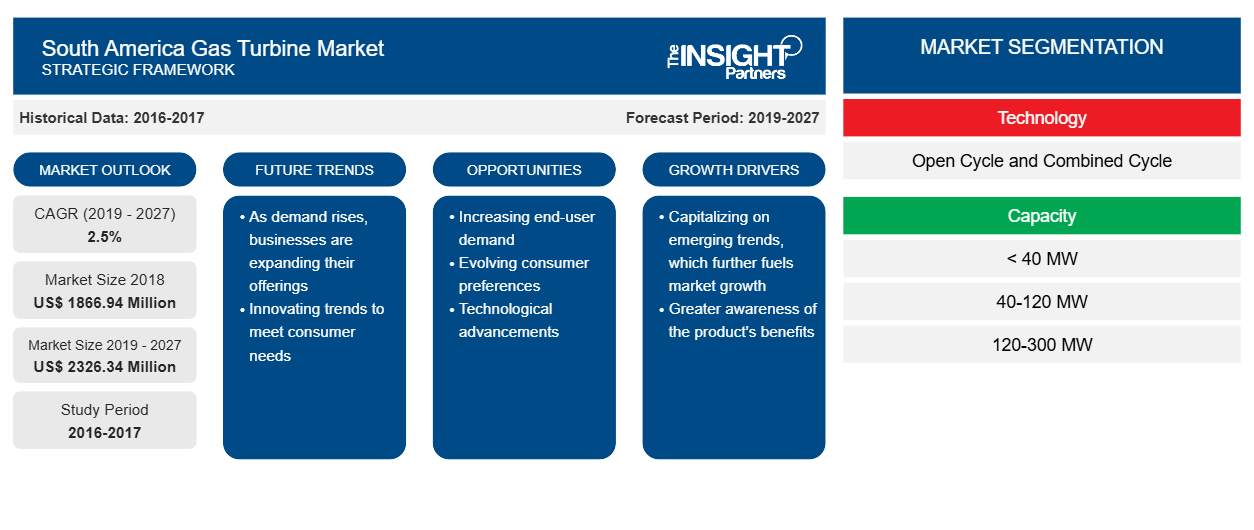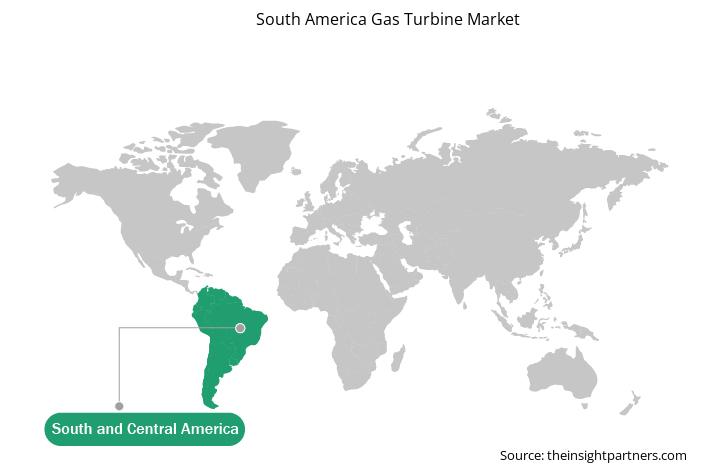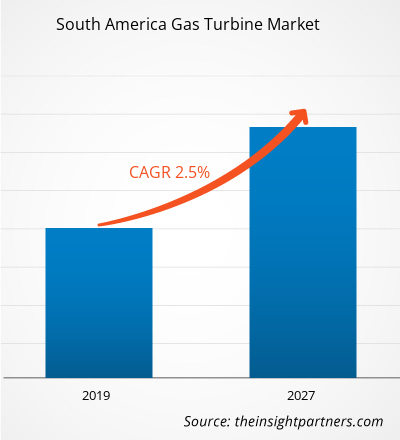南美燃气轮机市场规模预计将从2024年的12.8938亿美元增至2031年的17.1548亿美元。预计该市场在2025年至2031年期间的复合年增长率将达到4.3%。未来几年,市场对氢混和零碳燃气轮机的日益重视可能会为市场带来新的趋势。
南美燃气轮机市场分析
不断增长的能源需求和发电需求是南美燃气轮机市场增长的关键驱动因素之一。此外,预计天然气供应和基础设施建设将在2025年至2031年期间推动燃气轮机需求增长。政府为减少二氧化碳排放而推行的天然气替代煤炭政策预计将在分析时间段内推动燃气轮机市场的增长。此外,与可再生能源的整合以及对混合发电厂的关注将为在该市场运营的公司带来重大机遇。
南美燃气轮机市场概况
南美燃气轮机市场充满活力且不断发展,这得益于不断增长的电力需求、工业化、城镇化以及丰富的天然气资源。该地区的市场也受到政府推动从石油和燃煤电厂向清洁能源转型的举措的影响。对可靠发电的需求以支持经济增长也推动了该地区市场的发展。南美国家正经历快速的工业增长,因此对高效可靠的发电方式的需求也随之增加。与燃煤电厂相比,燃气轮机凭借其高效、灵活且低排放的特点,正逐渐被采用以满足这一需求。
各国政府和私营企业正在大力投资天然气基础设施,包括储存设施和管道设施。天然气行业持续的基础设施建设预计将支持燃气轮机市场的增长,确保为发电和利用各种相关气体的工业应用提供稳定的天然气供应。燃气轮机预计将在可再生能源并网过程中发挥至关重要的作用。它们能够提供持续的备用电源和电网稳定性,预计将使其成为南美洲能源转型格局的重要组成部分。此外,随着南美洲继续向低碳能源经济转型,燃气轮机预计将在弥合传统化石燃料与可再生能源之间的差距方面发挥重要作用。凭借对创新和可持续性的关注,该地区市场有望在预测期内成为全球能源格局的领跑者。
您可以免费定制任何报告,包括本报告的部分内容、国家级分析、Excel 数据包,以及为初创企业和大学提供优惠和折扣
南美燃气轮机市场:战略洞察

- 获取此报告的顶级关键市场趋势。此免费样品将包括数据分析,从市场趋势到估计和预测。
南美燃气轮机市场驱动因素和机遇
不断增长的能源需求和发电需求
由于南美洲主要国家的人口增长和工业扩张,该地区的电力需求正在上升。水力发电约占该地区电力供应的 54%,但面临气候变化的制约,以及各国政府因环境和社会影响而对大型水坝项目提出的抵制。2015 年至 2023 年间,该地区电力消耗年均增长率约为 1.8%,达到 594 TWh,而 2001 年至 2015 年间,年均增长率曾达到 3.8%。据巴西能源研究公司 (EPE) 的数据,2024 年巴西的电力消耗增长了约 5.3%,其中家庭用电增长超过 7%,而工业和服务业用电增长超过 5%。蓬勃发展的工业化和制造业的进步也刺激了对电力和发电的需求。汽车是巴西、阿根廷和智利最重要的行业之一,对这些地区的 GDP 贡献巨大。通用汽车、大众、菲亚特和丰田等国际汽车制造商已在圣保罗、米纳斯吉拉斯州和南里奥格兰德州等城市设立了制造工厂。巴西航空工业公司(Embraer)是一家以飞机制造闻名的巴西本土知名品牌,在工业和制造业领域也发挥着至关重要的作用。巴西近年来大力鼓励电动汽车(EV)生产,并通过新的投资来抢占日益增长的全球电动汽车市场的份额,这进一步刺激了对能源和发电的需求。
与可再生能源的整合以及对混合发电厂的关注
燃气轮机正与可再生能源相结合,以构建更灵活、更可持续的电力系统。这种整合使燃气轮机能够应对可再生能源(尤其是太阳能和风能)的间歇性,从而确保电网稳定并减少对化石燃料的依赖。随着发电趋势转向可持续燃料和可再生能源,先进的燃气轮机将在扩大天然气作为“过渡燃料”的竞争力方面发挥至关重要的作用。向可再生能源的过渡可以降低燃料消耗,并将温室气体排放降至最低。同时,可以实施二氧化碳捕获和其他烟气净化技术,以显著减少二次排放。
阿根廷政府已制定可再生能源发展目标。其国家能源计划旨在到2025年实现可再生能源发电量约20%的目标。此外,政府还计划到2030年将这一比例提高到约35%。政府已出台多项政策,支持该国可再生能源的发展。例如,政府的“可再生能源革新计划”(RenovAr)为可再生能源项目的发展提供财政激励;该计划包括为可再生能源项目和混合发电厂建设提供税收减免、补贴和软贷款。因此,可再生能源的日益整合和混合发电厂的普及预计将为南美燃气轮机市场带来丰厚的增长机会。
南美燃气轮机市场报告细分分析
有助于得出南美燃气轮机市场分析的关键部分是技术、产能和应用。
- 按技术划分,市场分为开式循环和联合循环。2024年,联合循环将占据市场主导地位。
- 按容量划分,市场分为40兆瓦以下、40-120兆瓦、120-300兆瓦和300兆瓦以上。2024年,120-300兆瓦容量的风电市场将占据主导地位。
- 根据应用,市场细分为发电、石油和天然气以及工业。2024年,发电领域占据市场主导地位。
南美燃气轮机市场份额(按国家)分析
南美燃气轮机市场细分为巴西、阿根廷和亚太其他地区。阿根廷在2024年占据市场主导地位,其次是巴西和南美其他地区。持续的技术和工业变革推动着巴西和阿根廷等国的经济发展。良好的经济条件、新兴制造业的扩张以及政府对扩大工业生产日益增长的支持,为南美燃气轮机市场参与者提供了巨大的增长潜力。此外,石油和天然气行业的持续发展预计将推动对燃气轮机的需求。尽管目前南美国家的燃气轮机使用率与北美等其他发达地区相比相对较低,但政府强调从煤炭和石油向天然气作为主要能源的转型,这可能会对这些国家的燃气轮机市场产生积极影响。在一些南美国家,燃气轮机与风能和太阳能等可再生能源的融合也正在兴起。这种混合方式提高了电网的稳定性和一致性,从而构建了更具弹性的能源系统。
南美燃气轮机市场区域洞察
Insight Partners 的分析师已详尽阐述了预测期内影响南美燃气轮机市场的区域趋势和因素。本节还讨论了南美燃气轮机市场在北美、欧洲、亚太地区、中东和非洲以及南美和中美洲的细分市场和地理位置。

- 获取南美燃气轮机市场的区域具体数据
南美燃气轮机市场报告范围
| 报告属性 | 细节 |
|---|---|
| 2024年的市场规模 | 12.8938亿美元 |
| 2031年的市场规模 | 17.1548亿美元 |
| 全球复合年增长率(2025-2031) | 4.3% |
| 史料 | 2021-2023 |
| 预测期 | 2025-2031 |
| 涵盖的领域 | 按产品类型
|
| 覆盖地区和国家 | 南美洲
|
| 市场领导者和主要公司简介 |
|
南美燃气轮机市场参与者密度:了解其对业务动态的影响
南美燃气轮机市场正在快速增长,这得益于终端用户需求的不断增长,而这些需求的驱动因素包括消费者偏好的转变、技术进步以及对产品优势的认知度的提升。随着需求的增长,企业正在扩展产品线,不断创新以满足消费者需求,并抓住新兴趋势,从而进一步推动市场增长。
市场参与者密度是指特定市场或行业内企业或公司的分布情况。它表明特定市场空间内竞争对手(市场参与者)的数量相对于其规模或总市值而言。
在南美燃气轮机市场运营的主要公司有:
- 三菱重工业有限公司
- 西门子股份公司
- GE Vernova公司
- 卡特彼勒公司
- 川崎重工业有限公司
- 贝克休斯公司
免责声明:以上列出的公司没有按照任何特定顺序排列。

- 获取南美燃气轮机市场主要参与者概览
南美燃气轮机市场新闻及最新发展
南美燃气轮机市场的评估基于一手和二手资料研究的定性和定量数据,这些数据包括重要的企业出版物、协会数据和数据库。市场的主要发展情况如下:
- GE Vernova公司宣布,其业界领先的H级燃气轮机技术已在全球116台机组上累计商业运行时间超过300万小时,相当于为超过5000万户美国家庭提供所需的电力。该机组通过提供高效、可调度的基载电力,并支持其能源转型和脱碳工作,使客户受益,预计将通过长期维护和服务合同为GE Vernova创造巨大价值。(来源:GE Vernova公司,新闻稿,2025年3月)
- GE Vernova公司宣布已完成对伍德沃德公司位于南卡罗来纳州格林维尔的重型燃气轮机燃烧部件业务的收购。此次收购对GE Vernova投资美国制造业和就业市场,同时强化其美国本土供应链的战略至关重要。(来源:GE Vernova公司,新闻稿,2025年3月)
南美燃气轮机市场报告范围和交付成果
《南美燃气轮机市场规模和预测(2025-2031)》对以下领域进行了详细的市场分析:
- 南美燃气轮机市场规模以及区域和国家层面所有主要细分市场的预测
- 南美燃气轮机市场趋势以及市场动态,例如驱动因素、限制因素和关键机遇
- 详细的 PEST 和 SWOT 分析
- 南美燃气轮机市场分析涵盖主要市场趋势、区域和国家框架、主要参与者、法规和最新市场发展
- 行业格局和竞争分析,涵盖市场集中度、热图分析、知名参与者以及南美燃气轮机市场的最新发展
- 详细的公司简介
- 历史分析(2 年)、基准年、预测(7 年)及复合年增长率
- PEST和SWOT分析
- 市场规模、价值/数量 - 全球、区域、国家
- 行业和竞争格局
- Excel 数据集
近期报告
客户评价
购买理由
- 明智的决策
- 了解市场动态
- 竞争分析
- 客户洞察
- 市场预测
- 风险规避
- 战略规划
- 投资论证
- 识别新兴市场
- 优化营销策略
- 提升运营效率
- 顺应监管趋势






















 获取免费样品 - 南美燃气轮机市场
获取免费样品 - 南美燃气轮机市场